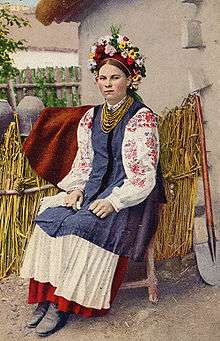Ukrainian wreath
.jpg)

The Ukrainian wreath (Ukrainian: вінок, vinok) is a type of wreath which, in traditional Ukrainian culture, is worn by girls and young unmarried women. The wreath may be part of a tradition dating back to the old East Slavic customs that predate the Christianization of Rus.[1] The flower wreath remains a part of the Ukrainian national attire, and is worn on festive occasions and on holy days and since the 2014 Ukrainian revolution increasingly in daily life.[2]
History
On the day of Ivan Kupala, young women placed their wreaths in the water with a lit-up candle, foretelling their romantic future by how the wreath flowed down the river or lake. From the wreath's direction, the girl could tell whom she would marry: if the wreath stayed in one spot and did not float down the water, she would not marry; if it went under, she would die; if the candle went out, misfortune would follow. The young men would dive into the water, trying to retrieve the vinok of the girl each loved. One of the ritual Kupala songs says, "Who will catch the wreath will catch the girl, who will get the wreath will become mine."[1] It dates back to pre-Christian times when it was thought that the headdress would protect girls from evil spirits. The ceremonial, religious value diminished, and was later replaced as a national character of girlhood: to lose a wreath in folk songs and traditions means for a maiden to transition into womanhood.[1]
In his book The Golden Bough, mythology scholar James George Frazer first claimed that Ivan Kupala Day (John the Baptist Day), celebrated in Ukraine and Russia shortly after the summer solstice, and closely associated with the wreath in Ukraine, was in fact originally a pagan fertility rite.
Appearance and construction
Like most Ukrainian folk dress, the vinok had significant symbolic value and only specific flowers were used.[3] It was traditionally worn by girls who were eligible for marriage. The wreath's name, vinok, is related to the Ukrainian word for a wedding ceremony vinchannya.
The flowers used to make the wreath were generally fresh, paper or waxen and were attached onto a band of stiff paper backing covered with a ribbon.
The wreath varied in many of the regions of Ukraine; young women throughout the country wore various headdresses of yarn, ribbon, coins, feathers and grasses, but these all had the same symbolic meaning. In parts of central and eastern Ukraine the flowers were raised in the center front. Usually multicolored, embroidered ribbons were attached to the back.[1]
During the Ukrainian wedding ceremony, the vinok was replaced by the ochipok, a cap that she would wear for the rest of her life.
The wreath is now worn by traditional Ukrainian dancers.
Neopaganism
Followers of the modern movement of Slavic Neopaganism attach a mystical significance to the wreath, weaving their wreaths of oak leaves and field flowers for their ritual celebration of the Summer Solstice.[4]
See also
 The wreath of flowers
The wreath of flowers The wreath of flowers
The wreath of flowers
References
- 1 2 3 4 Orysia Paszczak Tracz, Vinok, vinochok, The Ukrainian Weekly, August 1, 1999.
- ↑ In Ukraine, That Flower Crown Means More Than You Think, Vogue (FEBRUARY 5, 2016)
- ↑ Украинские национальные костюмы Женские головные уборы
- ↑ UKRAINE PAGANS CELEBRATE SUMMER SOLTICE. 5TV News. 4 July 2007. URL Access: 13 December 2007.
External links
![]() Media related to Ukrainian wreaths at Wikimedia Commons
Media related to Ukrainian wreaths at Wikimedia Commons
- Folk Clothing
- Skliarenko, Elyna Olehovna on the celebration of "Ivana Kupala" based on two separate works by R. Kobalchynska, and by L. Fenix (Ukrainian)